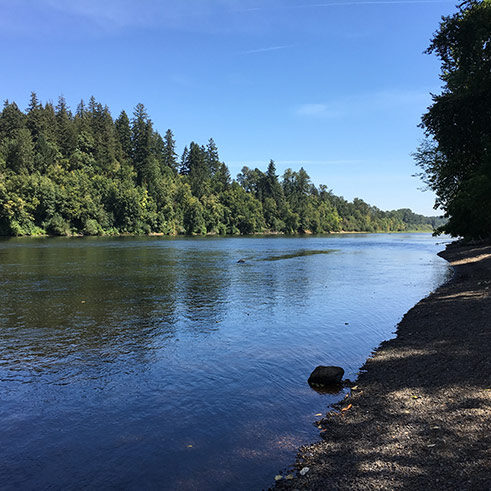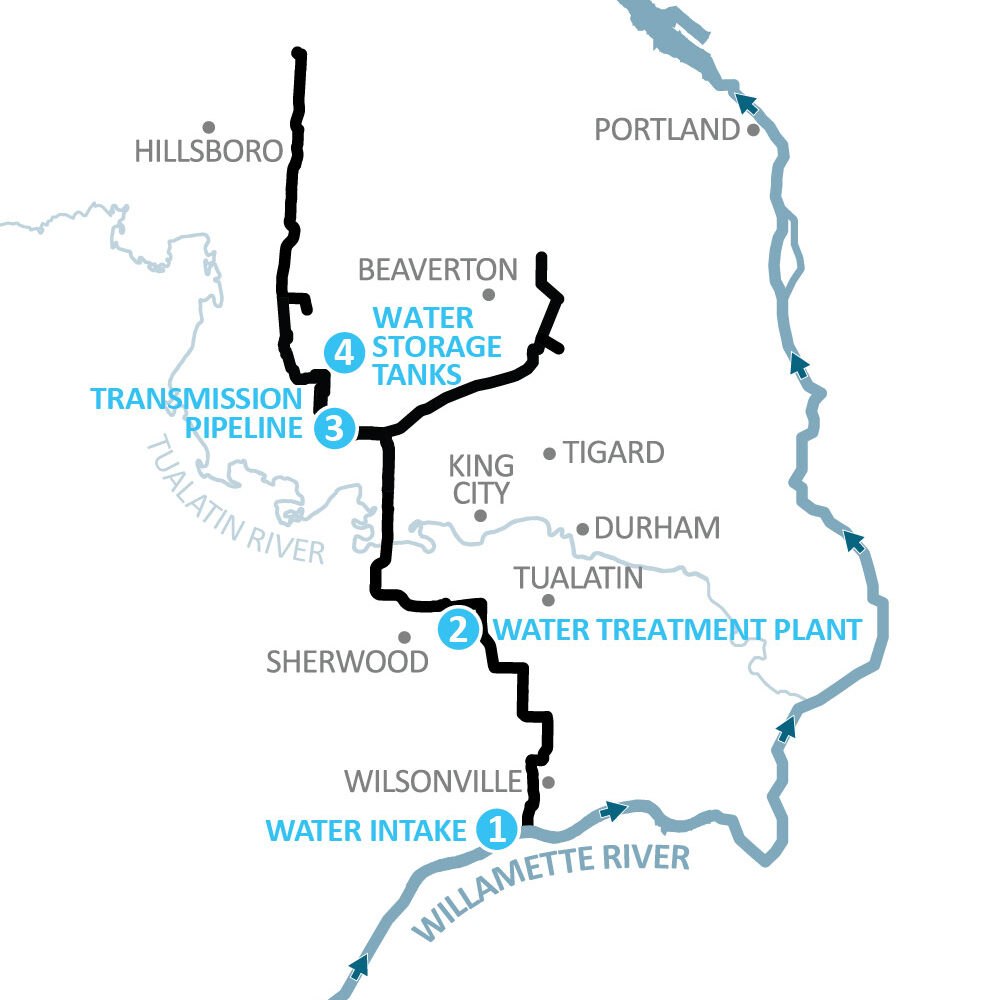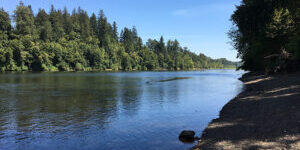
A strong El Niño season could mean another dry year for western Washington County
Before Victoria Lowe became a Forest Grove city councilor, she battled drought and water scarcity in Nevada and Texas.
After her arrival in Oregon, Lowe’s interest in protecting Forest Grove’s watershed drove her into the political arena, where she now hopes to spare Washington County residents from similar water shortages in the face of Oregon’s current drought.
“I would like to think about conservation before the last drop comes out of the pipe,” Lowe said recently.
Thankfully, western Washington County’s current situation isn’t that dire.
But without careful planning and citizen cooperation, it could be a lot worse than it is.
For the first time in 23 years, the county has been given a “drought” designation by the U.S. Department of Agriculture. The state’s Water Resources Department labels it “severe drought.”
Nearby cities Vernonia and Carlton are both in stage three emergency drought situations, while Banks is in stage one. All have enacted water restrictions.
But residents in Forest Grove, Cornelius and Hillsboro are in decent shape thanks to the Joint Water Commission (JWC). Serving four cities and one water district in Washington County, the JWC partnership has ensured water flows from the faucets of the 350,000 residents in its district for the past 30 years.
“We’re not about to run out of water,” said Rob Foster, Forest Grove’s director of public works.
Still, the JWC may be facing its biggest challenge yet with forecasters calling for a “Godzilla” El Niño season through next spring.
Another dry year possible
El Niño is a complex weather event in the Pacific Ocean that occurs every two to seven years.
It starts along the equator when trade winds die down and sea-surface temperatures rise up. It becomes official when sea-surface temperatures remain at least 0.9 degrees Farenheit above average for at least five three-month periods in a row.
Tom Di Liberto, a meteorologist with the National Oceanic Atmospheric Administration’s Climate Prediction Center, expects August’s temperature to confirm that the current El Niño season began this year during the February-to-April period.
The phenomenon lasts anywhere from seven months to two years and the current El Niño is on track to fit that pattern, with Di Liberto expecting it to continue through the March-to-May period next year. That would be the longest El Niño season since the 1980s.
Di Liberto ties this week’s hurricane phenomenon to El Niño. “This is the first time we’ve ever seen three major hurricanes in the central Pacific at the same time,” he said.
Elsewhere, El Niño usually brings heavy or even catastrophic rainfall to some areas and unusual heat or drought to others.
In the Pacific Northwest, El Niño sometimes brings greater rainfall, particularly west of the Cascades.
Its effects on the rest of the state vary, with deluge in some years and drought in others.
The one predictable aspect of El Niño in Oregon is warmth.
In other parts of the state, warmth is a huge problem because it means no snowpack in an area where snowpack is key to residents’ summer water supply.
In western Washington County, warmth is not a problem as long as it doesn’t stop the rain — because rain is what refills the two big Coast Range reservoirs that help provide water to Forest Grove, Cornelius and Hillsboro during the dry summer months.
This year was definitely drier than normal, but nobody knows if it will stay that dry next year.
“We don’t know that this is the new normal,” said Kristel Fesler, the water resource program coordinator for Hillsboro’s water department. “Temps are going to stay above average, but precipitation is much harder to predict.”
System keeps growing
Back in 1908, Forest Grove city officials bought roughly four acres of land in the Clear Creek Canyon area of the Coast Range, then hollowed out 10-foot fir logs and jammed them together with a 50-pound “battering ram” to create a 40,500-foot wooden pipe that would carry water from Clear Creek to the city.
The log pipes have since been replaced by metal and the watershed is now 4,225 acres instead of four, but nearly 110 years later, Clear Creek remains key to Forest Grove’s water supply.
Another source is the Barney Reservoir, built by Hillsboro in the 1960s and located in the Coast Range about 11 miles directly west of Gaston.
In 1972, the federal Bureau of Reclamation began building Scoggins Dam, adding more than 18 billion gallons of water to the county’s water supply through the Hagg Lake reservoir. It’s now three times the size of Barney, which was expanded in the 1990s to hold 6.5 billion gallons of water.
Both reservoirs feed into the Tualatin River, which has always been the sole water source for Hillsboro.
Other JWC partners can draw water from secondary sources during the rain-filled winter months. Forest Grove, for example, relies more on Clear Creek while Beaverton uses water from its aquifer system.
Hillsboro and the Tualatin Valley Water District (which serves unincorporated parts of Hillsboro and Beaverton) are creating their own secondary water source, spending $1 billion to create a system that will bring water from the Willamette River.
But during the dry summer months, all JWC partners usually rely on at least some reservoir water. And sometimes that can be problematic.
Cooperation is key
Hillsboro officials formed the JWC in 1976, believing a partnership with neighboring cities would benefit everyone in the long run.
They were right.
“It was all the generations before us that planned ahead,” Lowe said.
Each city served by the JWC — Hillsboro, Forest Grove, Beaverton and Tigard, along with the Tualatin Valley Water District — has relied on the others in case of a water emergency.
From 1997 to 2001, for example, the Pacific Ocean produced a long period of extreme weather, with an El Niño followed almost immediately by an unusually long La Niña, which arrives when sea-surface temperatures are unusually low instead of unusually high.
Hagg Lake’s water level dropped lower and lower each year, culminating in an epic water shortage in 2001.
That year, the Barney and Hagg Lake reservoirs collected only half the usual amount of water — a shortage that hadn’t happened at Hagg Lake since 1977.
Nevertheless, JWC partners never suffered because the Tualatin Valley Water District leased water from Portland while Tigard and Forest Grove used water from other sources, alleviating the pressure on Hillsboro, which also provides water to Cornelius. (See box).
“Forest Grove had more than enough water in 2001,” said Foster, who believes that shows how water-rich the city is.
During this year’s drought, in fact, Forest Grove not only had all the water it needed, but the city leased about 250 million gallons to Hillsboro and the TVWD.
Restriction plans ready
One confusing factor is that the 2001 water shortage followed an extended La Niña. Because La Niñas are caused by opposite temperature extremes from El Niños, they tend to cause opposite weather effects, Di Liberto said.
Based on historic patterns, the 1998-2001 La Niña should have brought more rain to western Washington County, while the current El Nino should bring less.
But preciptation from these weather events is not as predictable as temperature, Di Liberto said.
If there ever is a water shortage, the JWC has water-restriction plans ready.
Tacy Steele, public information officer for Hillsboro’s water department, will be watching to see whether abnormal weather conditions keep Barney Reservoir and Hagg Lake from reaching full capacity before next summer.
“Curtailment is on the menu if it gets to that point,” Steele said, “but it wouldn’t necessarily be mandatory.”
In the event of drought conditions prior to the summer, the JWC will let each agency know how much water they will get from the reservoirs and ask them to start cracking down on water use.
Each city has a unique list of stages and responses depending on how extreme the problem is. (See the Water Management and Conservation plan at bit.ly/1hryqh9.)
Conservation suggestions from the JWC — such as making faucets and showerheads more efficient — have been voluntary so far, but continued drought could eventually make them mandatory, as they are now for many other Oregonians.
“When an emergency situation does happen, we all will need each other,” Lowe said.
“Do you keep sucking on the straw until you get to the bottom, or do you better manage what you’ve got?”
Cornelius aquifer will be ready in Fall 2016
Hillsboro provides water to Cornelius, which is creating an underground aquifer storage and recovery system that will let it take more water from Hillsboro during rainy winter months when water is plentiful, then store it away for summer use.
City Engineer Terry Keyes expects the system to begin operating a year from now.
It won’t be available to help if rainfall is sparse this year, but Keyes says Cornelius still won’t run out of water.
“It just gets more expensive,” he said.
The good news is that the aquifer will store much more water than anticipated — up to 90 million gallons, Keyes said. “We were hoping for 50










